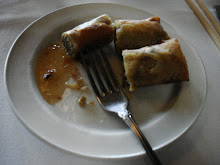Although fortune cookies are a modern invention, a legend has been developed and circulated to explain their origins. According to this legend, in the 14th century, when the Mongols ruled China, a revolutionary named Chu Yuan Chang planned an uprising against them. He used mooncakes to pass along the date of the uprising to the Chinese by replacing the yolk center of the mooncake with the message written on rice paper. The Mongols did not care for the yolks, so the plan went on successfully and the Ming Dynasty began. It is claimed that the Moon Festival celebrates this with the tradition of giving mooncakes with messages inside. Immigrant Chinese railroad workers, without ingredients to make regular mooncakes, made biscuits instead. It is these biscuits that may have later inspired fortune cookies.
Another theory of the origin of the fortune cookie dates back to the 19th century. A cookie very similar in appearance to the American Fortune cookie was made is Kyoto, Japan, and there is a Japanese temple tradition of random fortunes, called omikuji. The Japanese version of the cookie differs in several ways: they are a little bit larger; are made of darker dough; and their batter contains sesame and miso rather than vanilla and butter. They contain a fortune. Most of the people who claim to have introduced the cookie to the United States are Japanese, so the theory is that these bakers were modifying a cookie design which they were aware of from thier days in Japan. Fortune cookies moved from being a confection dominated by Japanese-Americans to one dominated by Chinese-Americans sometime around World War II.
This information compliments of a Wikipedia search on "fortune cookies".
Wednesday, July 15, 2009
Subscribe to:
Post Comments (Atom)

0 comments:
Post a Comment